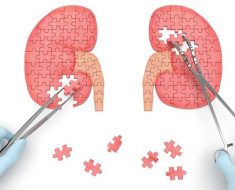A team of researchers from the U.S., China and Korea has developed a small, skin-like sensor that can be attached to a human patient to collect temperature and pressure information and wirelessly send it to healthcare workers. In their paper published in the journal Science Translational Medicine, the group describes the sensor, how it works and how well it did when compared with conventional sensors.
Taking the temperature of patients in a hospital setting is a quick way to test for the onset of an infection. Also, testing for pressure in patients bedridden for long periods of time can alert caretakers to the need to take action to prevent bedsores. While everyone knows how to take temperature, the process for testing for pressure is less well known—typically, it involves insertion of an uncomfortable anal probe. Methods for both kinds of tests also suffer from locality—they only offer information on one part of the body. In this new effort, the researchers have developed a sensor that can provide constant temperature and pressure readings from multiple sites—all without the need for any batteries.
The sensor the team developed is meant to be used as part of a set—several of the sensors are applied to the skin of the patient at various sites (on average, 65 of them, depending on the size of the patient). Each collects information and sends data to an NFC transmitting coil under the patient’s bed. The coil device also serves as the means of power for the sensors. Each of the sensors, which are about the size of a U.S. penny, has a pressure sensor, a temperature sensor and an NFC system. The device under the bed also serves as a relay, sending the data it receives to a computer that monitors the data and sends alerts to healthcare workers. The sensors, the team reports, are thin and flexible, allowing them to conform comfortably to the skin.
The team has already tested the system against conventional instruments and found them to be equally effective. A larger clinical trial is being planned even as the researchers look to see if they might be able to add other capabilities to the sensors, such as monitoring heart and respiration rate.

Source: Read Full Article





